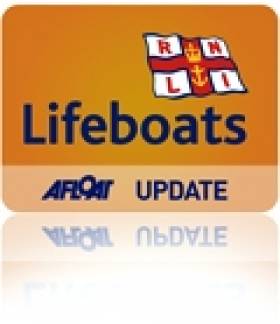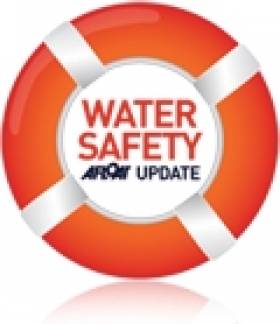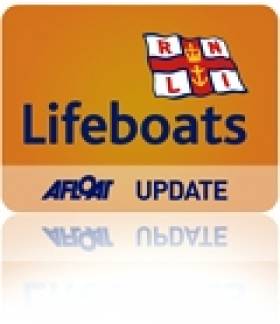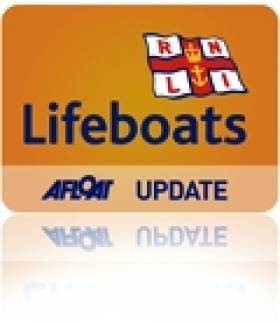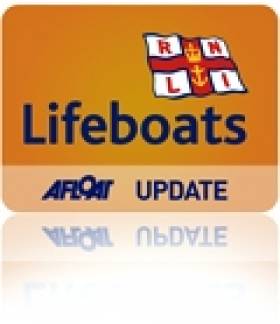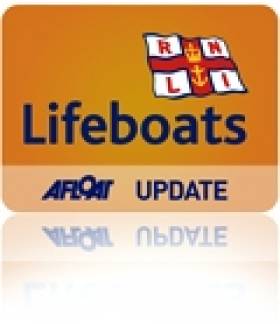Displaying items by tag: Lifeboats
Busy Days For RNLI Lifeboats In Co Down
#RNLI - Newcastle RNLI’s always-on-call lifeboat crew had to abandon their buckets and sponges during a fundraising car wash at the weekend to respond to an emergency at the Co Down town’s harbour.
The RNLI volunteers were busily soaping and rinsing cars for their annual Easter fundraiser on Saturday when they were alerted to a woman in trouble in the freezing water a few yards from one of the piers.
The car wash was immediately abandoned and within minutes the inshore lifeboat Aldergrove II was launched and rushed to the woman’s aid.
At the same time, crew member Shane Rice grabbed a lifebelt from the pier and jumped into the water to assist the woman. He kept her afloat while the Aldergrove II came alongside.
The woman was helped into the rescue inflatable, wrapped in blankets to prevent hypothermia, and taken back to shore where an ambulance was waiting to take her to hospital.
Newcastle RNLI’s deputy launching authority Clifford Moorehead said afterwards: "The lifeboat crew are always ready to respond in an instant to any emergency. It is fortunate that the car wash was in progress at the time and the crew members were on hand to swiftly deal with this case.
"After the rescue the crew members came back to the harbour and resumed their car wash. It’s just all in a day’s work for the RNLI."
It wasn't the only callout of the weekend for the RNLI in Co Down, as Bangor RNLI assisted a lone sailor who got into difficulty on a sailing dinghy Easter Sunday.
At 1.10pm the volunteer lifeboat crew received an urgent request from Belfast Coastguard to launch the lifeboat and rescue one person from a 17ft dinghy.
The sailing dinghy had reportedly gone aground on ‘Cockle Island’ off Groomsport Harbour on the southern shores of Belfast Lough.
Upon arrival at the scene, the volunteer crew found that the occupant onboard the dinghy had been assisted by another boat owner and the vessel had been safely tied to a mooring buoy.
Meanwhile, last Wednesday evening Portaferry RNLI was launched to reports that red flares has been sighted on Strangford Lough off Kircubbin in Co Down.
They were joined by a coastguard team that searched the shoreline and after some time recovered a spent flare casing. The inshore lifeboat and its volunteer crew were stood down after a number of hours with the callout proving to be a false alarm.
Portaferry RNLI lifeboat operations manager Brian Bailie said: "A member of the public acted in good faith ... alerting the emergency services to what they understood to be a distress flare on the lough."
He reiterated that flares "should only be used in emergency situations".
NI Lifeguards To Feature In New TV Series
#WaterSafety - RNLI lifeguards in Northern Ireland are to feature on a new television series on UTV.
The Magazine starts on Sunday 7 April at 7.30pm with host Sarah Travers in her home town of Portstewart to introduce viewers to some of her favourite people, places and topics.
As part of the first programme, TV presenter Emma-Rosa Dias will find out what it takes to be a lifeguard with the RNLI when she visits the charity’s area support centre in Ballymoney - before being put through her paces by RNLI lifeguard supervisor Tim Doran to see if she is ready for the challenge.
After a test in the swimming pool, Dias experiences a slice of the real thing when she pays a visit to Portrush East Strand on the Causeway Coast, one of the five beaches in Northern Ireland which begins its Easter season on Good Friday tomorrow 29 March.
As previously reported on Afloat.ie, this lifeguard cover will run throughout Easter week until Sunday 7 April.
Filming took place on Monday afternoon and despite the unseasonal weather, the charity’s highly trained lifeguards took the opportunity to demonstrate that they will be ready to assist the visitors who will brave the elements and take a trip to the seaside over the Easter break.
Speaking following the afternoon’s shoot, Tim Doran said filming with UTV was a great way to show how highly trained RNLI lifeguards are.
"Our lifeguards spot potential dangers before they develop, and are on hand to give appropriate safety advice and respond immediately if anyone gets into difficulty," he said. "Because our lifeguards work closely alongside our volunteer lifeboat crews, it means the RNLI offers beach-goers and water-users a seamless rescue service from beach to open sea."
While Easter is often the time when people are getting back in the water after the winter, and while it’s good to see people enjoying the beaches, the RNLI is encouraging visitors to make sure they have the right kit to keep warm.
"It’s much colder now then it was this time last year," Doran added, "and our lifeguards will be wrapping up and we’d encourage everyone else to do the same. So, if you are heading into the sea, make sure you’re wearing a good wetsuit or drysuit, go with other people and keep an eye on each other.
"Keeping warm in cold weather can take a lot of energy, so fatigue can be an issue, plus watch out for the wind chill factor – even a slight breeze can have a dramatic effect on how cold it feels."
Meanwhile, to find out how Emma-Rosa Dias gets on, tune into UTV at 7.30pm on Sunday 7 April.
Howth Duo Cycling From London To Paris For RNLI
#HowthRNLI - Howth locals Jennifer Murphy and Brendan Mulligan will be taking part in the London to Paris Bike Ride in aid of Howth RNLI.
The 377km charity challenge will take place between 23 and 26 August. Riders will depart from London and cycle past Hampton Court and through the North and South Downs to Portsmouth.
After crossing the English Channel on a ferry they will arrive in France at Caen and travel through the French countryside to Evreux. On the final day, all the cyclists will head to their final destination of the Arc de Triomphe in Paris.
Murphy said: "We decided to do the challenge for Howth RNLI because it is a local charity. We know some of the volunteer crew, including my boss!"
The duo are collecting sponsorships at their MyCharity.ie page HERE.
And according to Howth RNLI's Rise Michael, the funds they raise will ensure the north Dublin volunteer lifeboat crews can go to sea with the best equipment available, preserving their safety when saving lives at sea.
Meanwhile, Howth RNLI is hosting a 'boat jumble' sale at Howth Sea Angling Club from 10.30am to 1pm on Saturday 13 April.
All are welcome to bring along boat gear, fishing gear, dinghies, wetsuits, sails, books and any other nautical-related items.
Tables cost €20 each, with 25% of sales donated to the RNLI. Alternatively, items can be donated to ‘The Bosun’s Locker’ with all sale proceeds going to the RNLI.
The RNLI Sea Safety Team will be on hand to check lifejacket safety and give advice, and RNLI souvenirs will also be available. For more details contact Barbara Sargent on 01 832 5392 or Rose Michael on 087 255 2726.
Michael adds that the funds raised by the jumble sale will go towards Howth RNLI's current fundraising project to fund the running and maintenance costs of the lifeboat station for a week.
Fenit RNLI Bid to Save Stranded Dolphin
#rnli – Lifeboat crew with Fenit RNLI and three local families worked together last night (Tuesday 26 March) to save the life of a stranded dolphin in the Kerry town. The mammal was running out of time after he was washed up into a deserted channel on a remote beach on Fenit Island and was not able to return to the water.
In a rescue operation that involved members of the Egan, Tobin and McCarthy families, three RNLI volunteer lifeboat crew, an inshore lifeboat and a jeep, the dolphin was given a fighting chance and was safely deposited by the lifeboat crew out in deep water.
The drama began when local woman Breda McCarthy was out walking her dog on Fenit Island when she came upon the stranded dolphin. It was lying in a small channel quite a few metres from the sea. It is believed the dolphin had swam in at high tide a few hours earlier and had got cut off from the sea. Mrs McCarty contacted family members who came down to see if they could return the dolphin to the water. Unfortunately this was not possible as the mammal kept to the shallow waters and would not return to the sea.
With their concern growing the families contacted Ger O'Donnell, Fenit RNLI Lifeboat Operations Manager to see if the RNLI could assist them. Ger in turn made contact with Valentia Coast Guard who put him in contact with a dolphin expert. After discussing the situation with the expert it was decided that the best course of action for providing a safe outcome would be to transport the dolphin down to the harbour and then transport it by RNLI lifeboat out to sea to be released.
The dolphin was carefully wrapped up and transported by jeep to the harbour where RNLI lifeboat crew were already waiting in the inshore lifeboat to launch. They took the dolphin onboard the lifeboat and proceeded immediately out to sea. On releasing the dolphin into the water the lifeboat crew watched as the mammal slowly started to swim around the lifeboat in ever increasing circles, gaining confidence as it went. Once they were satisfied the dolphin was able to safely swim away, the lifeboat crew returned to shore.
Commenting on the unusual callout Fenit RNLI Lifeboat Operations Manager Ger O'Donnell said, "This was not your run of the mill rescue for the lifeboat crew. We were very anxious that we did everything right and gave the poor thing the best chance of survival. I want to thank everyone involved. It was a real community effort, from the local families, the RNLI crew and the Coast Guard, who were able to put us in touch with the expert advice we needed. It was almost as if the dolphin knew we were working to save him and I sincerely hope that he made it and we can count him as another life saved."
Local woman Mary Tobin, whose son Michael captured some photos of the incident said, "It was great to see everyone working together. I can't thank them enough, we were so worried the poor creature was not going to make it. When my sister Breda found him it was clear that he was in a bad way and his breathing was very laboured. We knew that with the RNLI on our doorstep that we would have a good shot at a successful outcome.
Dun Laoghaire Lifeboat Crew Give it Some Welly
#rnli – With the recent downpours, the RNLI is calling on people to put their wellies to good use and support their forthcoming MAYDAY appeal. The charity that saves lives at sea is asking the public to hold a welly themed fundraising event or buy a special yellow welly RNLI MAYDAY key-ring to raise funds for the lifeboat service in Ireland. The RNLI MAYDAY appeal is supported by John West.
The yellow welly is an essential piece of the RNLI volunteer lifeboat crewmember's kit. Waterproof with steel-capped toes, the specially designed boots keep the volunteer crew's feet warm and dry while also protecting them in dangerous conditions on deck. During gale force winds, rain and ice, keeping a sure footing can literally mean the difference between life and death for our volunteers. A pair of yellow wellies for a volunteer costs €50 but supporting the RNLI's MAYDAY appeal and buying a yellow welly key-ring will cost just €2.
RNLI MAYDAY is set to run from the first to the sixth of May with yellow welly key-rings being sold by volunteers in many shopping centres and towns around Ireland. Companies can also request a box of the MAYDAY key-rings to sell in their work place or hold their own welly fundraiser.
RNLI Corporate Manager Rhona O'Connor said, "We are asking people to give it some welly and get behind RNLI MAYDAY. Wellies are something that we are all too familiar with recently. Whether it's for getting around in bad weather or attending festivals and outdoor gigs, we love our wellies. The RNLI volunteer lifeboat crew love their wellies too and want people to help them raise funds. So whether it's a wear your wellies to work fundraiser or simply buying a yellow welly MAYDAY key-ring we hope people will give it some welly for the charity which has been saving lives since 1824."
Supporting MAYDAY Dun Laoghaire RNLI volunteer crewmember Rob Landers commented, "We are delighted to be associated with the RNLI MAYDAY appeal. As a volunteer crewmember I benefit directly from the training and the equipment that the charity provides for its lifeboat crew. We rely on the support and the generosity of the public to ensure the lifeboat crews based around Ireland can continue to save lives at sea and on inland waters."
The RNLI MAYDAY appeal is proudly supported by John West who themselves have a long seagoing tradition. Since 1857 the company has had their own fleet of fishing boats. John West Chief Executive Brendan Murphy added, "At John West we know first-hand the reality of the power of the sea, and we fully appreciate and support the work that the RNLI do in saving lives everyday throughout Ireland."
Last year RNLI lifeboats in Ireland launched 939 times to bring 1,041 people to safety. Volunteer lifeboat crew answer all types of maydays. It was a busy few days for the RNLI around the country with Wicklow RNLI launched last Friday in gale force conditions to bring a French fishing vessel with four people onboard to safety. While yesterday (Monday 25 March) Howth RNLI launched their inshore lifeboat when a father and daughter became stranded on the East pier due to high waves. The pair were taken onboard the lifeboat after a crewmember walked them to safety, through breaking waves, from the alcove where they were sheltering. In Cork Ballycotton RNLI launched to rescue a lone sailor in difficulty. On arrival at the scene, lifeboat crew boarded the vessel and took the man onboard. The decision was made to have him airlifted by the Irish Coast Guard helicopter from Waterford and taken to hospital for treatment.
Events already planned for RNLI MAYDAY include a welly walk down Dun Laoghaire pier in Dublin on Sunday 5 May, an open water swim in Dunmore East, Waterford and the Sherkin Island to Baltimore sea swim in west Cork, also on the Sunday. For a list of scheduled events, fundraising ideas and to register an event visit: www.rnli.org/MAYDAY or call: 01895 1837
Portrush Boatowners look forward to Annual Boat Jumble
#boatjumble – Portrush Boatowners Association is eagerly looking forward to the annual boat jumble at Portrush Harbour on Saturday 30th March 2013.
The boat jumble which is usually held in October was rescheduled to Easter Saturday, so that visitors to Portrush could enjoy the event, which combines a gathering of the local boatowners raising funds for charity and a bit of banter and craic. The Charities benefitting this year are Chest Heart and Stroke and Portrush Lifeboat Station.
The jumble takes place on the North Pier and consists of stalls and car boots selling all things nautical and maybe not so nautical. It gives boatowners a chance to buy boating paraphanalia as well as maybe the odd boat up for grabs.
The local Coastguard will be on hand to give Sea Safety advice and the Portrush Lifeboat will hopefully be alongside side with her crew, which offers an excellent opportunity to have a tour of the lifeboat and ask the crew questions about how she works.
Also this year the Association have asked local men Andy McClelland and John Lynn to come along with their boats.
John is planning to sail solo from Islay to Portrush in his laser dinghy retracing the steps of his late father Robert who made the same journey on a windsurfer. John will also be raising funds for Portrush Lifeboat Station.
Local Lifeboat crew member and Junior World Kayaking Champion Andy McClelland wil be kayaking 22 miles across the Irish Sea in May in aid of kidney research, Alzheimers Society and the regional respiratory Belfast City Hospital.
There will be an opportunity to talk to both John and Andy about their plans.
Charlie Grossie Chair of the Portrush Boatowners Association commented:-
'"The Association is yet again proud to be able run the Boat Jumble in support of the RNLI and the NI Chest Heart and Stroke charities. We are hoping for good weather and good turn on the day. We look forward to being able to make a healthy donation in support of both charities".
The Boat Jumble starts at 10am to 3pm on 30th March 2013. Stalls/Cars caost £25 and entry fee is £3 for adults, children get in free.
Kilrush RNLI Responds To 'Flare' Sightings Off West Coast
#RNLI - Kilrush RNLI launched twice on Tuesday 19 March to a reported flare or red smoke sighted off the coast on the River Shannon.
On both launches at 12.15pm and later at 9.27pm, both crews quickly assembled and set off to the locations along the river outlined by Valentia Coast Guard.
On the first callout, the volunteer lifeboat crew searched from Querrin Point to Cappa village following accounts from the public that a small aircraft had been seen aflame while on approach.
Shannon helicopter and crews from the Kilkee and Mallow coastguard who were involved with another incident in Ballybunnion, crossed the waters and joined in the search.
After two-and-a-half hours the search was stood down as the Aviation Department stated there were no aircrafts in the region. The conclusion thus far is that the object seen was a meteorite burning up in the atmosphere.
Shortly before 9.30pm, the inshore crew was paged again by Valentia Coast Guard to launch in response to members of the public who saw flares in the Kilrush area.
The lifeboat launched and after an hour was stood down as there was no evidence along the shore from Cappa to the Moneypoint area. The unit of the Kilkee Coast Guard also carried out an intense shore search.
Kilrush RNLI helm and volunteer lifeboat press officer Pauline Dunleavy praised the members of the public who put these calls into action, even though in this case they turned out to be false alarms.
"We would urge anyone who does see anything suspicious out on the water to dial 999 without delay," she said. "It could be the reason a life was saved."
#RNLI - Arranmore RNLI was involved in an epic 12-hour rescue in difficult weather of five fishermen on board a crabber which got into difficulty on St Patrick’s Day.
The station’s all-weather lifeboat was launched at 1.45pm to go to the assistance of the 15-metre fishing vessel which had lost power some 40 miles north west of Arranmore due to a rope getting tangled in the propellers. The five crew members on board the boat were not in immediate danger.
Arriving on scene at 4.30pm, the lifeboat crew, under second coxswain Jimmy Early, established a tow line and proceeded to escort the stricken vessel into Burtonport. However, due to a heavy five-metre swell, the journey was slowed down by the tow line breaking.
Arranmore RNLI volunteer lifeboat press officer Nora Flanagan said: "This was a long callout for all concerned, but our lifeboat crew was delighted that they were able to assist the five crew members and bring them and their fishing vessel safely to shore which they did shortly before 2am this morning (Monday 18 March)."
This was the first long-haul callout for Arranmore’s newest and youngest crew member, 17-year-old Dominic Boyle. The second youngest crew member - Leigh Early, son of coxswain Jimmy - was also on the call.
Meanwhile, three crew members from Courtown RNLI have been presented with animal welfare awards for their bravery in rescuing a woman and her dog from Courtown Harbour last December.
As previously reported on Afloat.ie, the 29-year-old woman got into difficulty when she attempted to rescue her Jack Russell, Holly, from the freezing water off Courtown pier.
The North Wexford Society for the Prevention of Cruelty to Animals (SPCA) awarded David Switzer, Aine Stafford and Fintan O’Donoghue for their efforts in rescuing the woman and her dog.
Colin Webb, chairman of the animal welfare group, said the society took strength from seeing examples of great compassion towards animals in the community.
Arklow RNLI Tows Stricken Whelk Vessel To Harbour
#RNLI - Arklow RNLI assisted the crew of a whelk fishing vessel which got into difficulty yesterday (Thursday 14 March).
The volunteer crew launched their all-weather lifeboat, the Ger Tigchlearr, shortly before 9am to go to the aid of a local fishing vessel.
The boat's crew had been fishing four miles south-east of Arklow Harbour when the vessel fouled its propeller.
The lifeboat was on scene within minutes and having ascertained the status of the casualty, the crew established a towline and proceeded to tow the stricken vessel back to Arklow Harbour.
The fishing boat's crew stayed aboard and all hands came ashore later at Arklow Harbour.
Following the callout, Arklow RNLI volunteer lifeboat press officer and sea safety officer Mark Corcoran said: "Even in good conditions at sea, things can and do go wrong.
"If anyone finds themselves in difficulty at sea they should call for help on 999 or 112 or call the coastguard on VHF radio."
The assist came a week after Arklow RNLI aided three fishermen whose vessel was adrift four miles off the Wexford coast, as previously reported on Afloat.ie.
Kilmore Quay RNLI Tends to Fishing Vessel in Epic Callout
#RNLI - The volunteer lifeboat crew at Kilmore Quay RNLI in Co Wexford responded to an 11-hour callout yesterday morning (Sunday 10 March) involving a 23-metre fishing vessel that had got into difficulty 40 miles south of the harbour. See video of the operation below.
With a biting easterly wind, the lifeboat crew made their way just after 8am to the vessel, which had suffered machinery failure, and arrived on scene at 10.40am.
Establishing a tow between the lifeboat and the fishing vessel with five crew onboard, the two vessels made slow progress back to shore in worsening conditions.
Commenting on the long callout, Kilmore Quay RNLI volunteer lifeboat crew member Aidan Bates said: “It was a bad day for a callout yesterday but the fishing vessel needed our assistance and the weather was worsening by the hour. By the time we were returning with the boat under tow the winds were blowing gale force seven to eight and it was choppy enough.
"Thankfully everyone was safe and the lifeboat crew were able to return home after a long day at sea.”


























